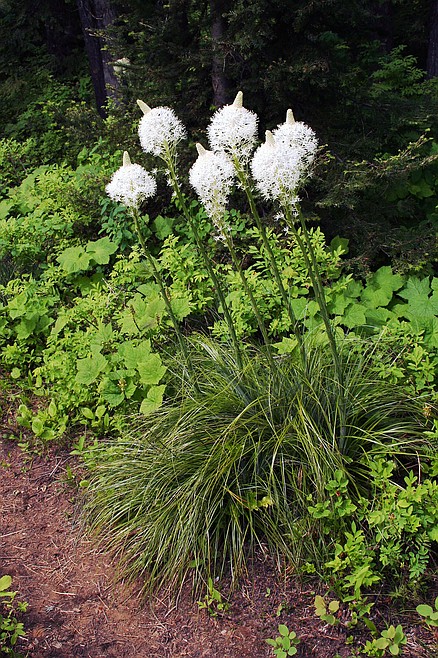Beargrass adds breathtaking beauty to gardens
KINNIKINNICK NATIVE PLANT SOCIETY | Bonner County Daily Bee | UPDATED 1 year, 5 months AGO
Beargrass (Xerophyllum tenax) is one of only two species in the genus Xerophyllum, both of which are native only to North America – one in the northwest and the other, commonly called Turkey Beard, in the southeast. Beargrass or Indian Basket Grass is found in open woods and clearings at mid-elevations up to 7,000 feet from British Columbia to central California and east to the Rocky Mountains.
Beargrass is not a grass, but is in the Lily order, in the Corn Lily family (Melanthiaceae). The derivation of its scientific name gives us clues to its character: Greek xeros means “dry,” and phyllon is “leaf.” In Latin, tenax translates as “grasping, tenacious.” The common name Beargrass comes from bears eating the young shoots and harvesting leaves as lining for winter dens.
Beargrass grows in dense clumps of long (up to 36 inches), narrow (up to 1/2 inch wide), basal leaves. As the leaves mature they are tough and fibrous. At their base the leaves cup around the stem then extend gracefully, narrowing to a thin, stiff tip. They have a rib line on the underside, called a keel, and the leaf margins are rough with very fine teeth. Leaves growing up the flower stalks are considerably shorter than the basal leaves.
And ah, the flowers! They appear on stalks ranging from a few feet to five feet tall in a dense cluster, blooming from the bottom upwards. The flowers are white, star-shaped and only about one-half inch in diameter. As a cluster they look like a fluffy pom-pom topped by a pointed tip of unopened buds.
Each tiny blossom has six delicate tepals (three sepals and three petals that are indistinguishable from each other). Six stamens on long violet filaments topped by yellow pollen bearing anthers extend well beyond the tepal ring. Anywhere from 50 to 400 individual flowers can appear in succession on one bloom stalk, called a terminal inflorescence.
Beargrass blooms from May to August depending on elevation, but not necessarily every year. Myth has it that flowers appear every seven years, but bloom is more related to the right mix of soil, temperature, water and nutrient conditions. A good bloom year for Beargrass is breathtaking, and according to some Native American Indian lore, it foretells a good huckleberry year as well.
Reproduction happens both by seed and from offsets developing on the tuberous, semiwoody rootstock called a rhizome. Each offest, when mature, produces one bloom stalk. After blooming that plant dies back, but is replaced by new offsets which are constantly developing.
Beargrass was an important plant to the Native cultures sharing its habitat. The rootstock was boiled or roasted for food. The flexible, sturdy leaves were used to fashion watertight baskets, capes and hats. Beargrass leaves, properly harvested and prepared, were dyed and used in many decorative items. They were versatile and valuable enough to be traded with tribes outside their natural range.
The art of basket weaving in Native cultures is a sacred practice. While it showcases the skill of an individual weaver, its style and decoration can also present a picture of a tribe's history and mythology. Baskets are used to pass tribal knowledge down through the generations.
Native tribes cultivated Beargrass areas by periodically setting fires to burn off the surface vegetation. Beargrass rhizomes easily withstand light burning, with the plants coming back stronger and more prolific from the rootstock. Fire management by suppression followed by more intense wildfires and logging have threatened Beargrass to the point that it is considered endangered in many places where it was once abundant.
Beargrass was also part of the Native medicine cabinet. The roots have styptic qualities and a poultice of chewed or mashed root was used to staunch bleeding wounds. Sprains and broken limbs were treated with a wash made from grated root.
Beargrass prefers full or filtered sun. It is drought tolerant, but needs early water from snowmelt. The foliage provides year round texture and, when in bloom, it is spectacular. It will grow in clay soils as well as acidic soils rich in humus. Once established, it spreads slowly through rhizome offsets. Collected seed should be scarified in cold for 12-16 weeks before planting, or planted out in the fall letting winter temperatures do the job.
Beargrass grows in the sub-alpine habitat of the North Idaho Native Plant Arboretum, 611 S. Ella Ave., in Sandpoint. Pictures and a description are found in “Landscaping with Native Plants in the Idaho Panhandle,” a KNPS publication available at local bookstores and the Bonner County History Museum.
Native Plant Notes are created by the Kinnikinnick Native Plant Society. To learn more about KNPS and the North Idaho Native Plant Arboretum, visit www.nativeplantsociety.org.




